Repeal the House of Representatives Resolution 121 to stop aggravating int’l harassment by Korean propaganda & lies!
Sign Our Petition!
Go to http://wh.gov/lBwa
GEISHA, TONY BLAIR & COMFORT WOMEN [Yujiro Taniyama]
Korean desecration of USA Korean War Memorial
Comfort Women Issue(US TV show 2007.3)
interviewee Mr. Komori from Sankei Daily
What is the “Comfort Women Issue?”
The term “comfort women” refers simply to prostitutes in wartime. But Koreans have long been promoting the “Discount Japan campaign”,a false version of history that Japan abducted hundreds of thousands of
Korean women and coerced them into sexual services for Japanese soldiers outside of Japan during World War Ⅱ.
This is, for practical and logical reasons, a fictitious version of history.
The U.S. Miltary official document “Japanese Prisoner of War Interrogation Report No. 49.” exclusively and vividly shows how well comfort women were treated. They were simply not sex slaves.
********************************
A Korean comfort woman named Moon Ok-ju, a former prostitute who worked in Burma, visited the Shimonoseki Post Office in Japan to withdraw her savings, and found out her original ledger was discovered and confirmed.(Note: In Japan, the Japanese Post Office has several banking functions.)
She worked in Burma during the period of two years and three months between June 1943 and September 1945, and accumulated a total savings of 26,145 yen in deposits at the military post office. In the 1940s, 5000 yen would have been enough to purchased a house in Tokyo.
A former Korean comfort woman’s deposits:
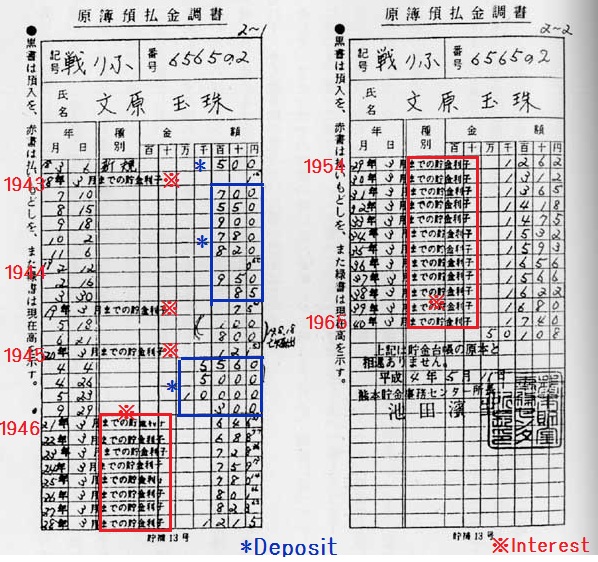
********************************
Newspaper advertisements recruiting comfort women appeared in the Keijo Nippo and Mainichi Shinpo, the large Korean daily papers during that era, stating that remuneration was 300 yen per month, and that advances of up to 3,000 yen might be granted. The monthly pay of a Japanese Army private at the time was 7.5 yen, and a sergeant made 30 yen.
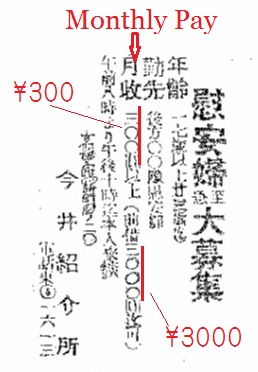
Advertisement in Keijyo Nippo (Seoul Daily, Japanese language newspaper published in Keijo, the colonial capital of Korea,) , 26th July 1944 edition.
Advertisement in Keijyo Nippo (Seoul Daily, Japanese language newspaper published in Keijo, the colonial capital of Korea,) , 26th July 1944 edition.
Source material released by the Korean government in an attempt to demonstrate that Korean women were coerced into serving as comfort women; strangely enough, it includes newspaper advertisements for comfort women
********************************
During the annexation of Korea by Japan, all the mayors of the villages in Korea were Korean, and most of the police officers were Korean.
The South Koreans insist that 200,000 women were abducted by the Japanese troops from villages.
To abduct such a huge number of women would not have been easy.
If Japanese troops had abducted the women from the villages, where were all the village mayors and policemen? Why didn’t the Korean people do anything to guard and help the women? Why didn’t they do anything when their people, and especially their women, were taken away by the Japanese troops? Why weren’t there anti-Japan movements?
********************************
In 1983, a former Japanese soldier,Seiji Yoshida, suddenly claimed that Japanese soldiers had hunted for Korean women in Cheju to force them into sex service for Japanese soldiers. However, elderly people who were familiar with the situation during that time denied this claim in the Cheju newspaper in 1989. One 85-year old woman at that time said that if 15 women had actually been forcibly taken away from a village with only 250 families, it would have been big news, but, she said, that did not happen. And even the Japanese soldier in question admitted he lied in 1995.
Afterwards, with agitation from Japanese leftist groups, many Korean women suddenly started speaking out, saying, “I was one of the comfort women” to possibly receive a large compensation from the Japanese government in 1991. However, it is very strange that not a single woman came forward for more than 40 years after the war.
The testimonies of these women are vey difficult to believe because their “facts” change with each telling. It has been documented that some of these women have changed their stories more than ten times. Their testimonies are not backed by provable facts or documentation. See the table below.
Differing Versions of Lee Yong-Soo’s Account of Her Kidnapping
Lee Yong-Soo is a former comfort woman who lives in Seoul at Nanum House, a home for former comfort women. She has visited Japan several times to tell her story.
|
Date of testimony |
Circumstances of kidnapping |
||
|
1 |
Report submitted to Korean Council for Women Drafted for Sexual Slavery by Japan Akashi Shoten, ed., Shogen: kyosei renko sareta Chosenjin gun ianfutachi (Testimonies of forcibly recruited Korean comfort women) (Tokyo: Akashi Shoten, 1993), pp. 131-143. |
1992 |
Delighted to receive a red dress and leather shoes from a man wearing clothing resembling a uniform. Went along with him right away (otherwise, same as 6). |
|
2 |
Women’s International War Crimes Tribunal on Japan’s Military Sexual Slavery |
December 2000 |
Deceived by Japanese man (comfort station proprietor) |
|
3 |
Akahata (Japan Press Weekly, Japanese Communist Party’s paper) article |
26 June 2002 |
Kidnapped at bayonet point at the age of 14.. |
|
4 |
Speech at Kyoto University in Japan |
12 April 2004 |
Kidnapped by a man wearing clothing resembling a People’s Army uniform. |
|
5 |
Koshigaya (Saitama Prefecture, Japan) community meeting |
08 March 2005 |
Kidnapped by a man wearing clothing resembling a military uniform and brandishing a rifle. |
|
6 |
Hearing at U.S. House of Representatives |
15 February 2007 |
In the autumn of 1944, when I was 16 years old, my friend, Kim Punsun, and I were collecting shellfish at the riverside when we noticed an elderly man and a Japanese man looking down at us form the hillside. The older man pointed at us with his finger, and the Japanese man started to walk towards us. The older man disappeared, and the Japanese beckoned to us to follow him. I was scared and ran away, not caring about what happened to my friend. A few days later, Punsun knocked on my window early in the morning, and whispered to me to follow her quietly. I tip-toed out of the house after her. I lift without telling my mother. I was wearing a dark skirt, a long cotton blouse buttoned up at the front and slippers on my feet. I followed my friend until we met the same man who had tried to approach us on the riverbank. He looked as if he was in his late thirties and he wore a sort of People’s Army uniform with a combat cap. Altogether, there were five girls with him, including myself. |
|
7 |
Japan Times article Testimony given at House of Councillors’ Building on February 21, 2007. |
22 February 2007 |
“On an evening in 1944, Japanese soldiers forced their way into 14-year-old Lee’s home and dragged her out by the neck.” |
|
8 |
FCCJ (Foreign Correspondents’ Club of Japan) Lee’s testimony and a taped question-and-answer session |
02 March 2007 |
A soldier and a woman entered her house between 2:00 and 3:00 a.m. on a bright moonlit night. [The soldier] pointed a sword at her, covered her mouth and removed her from her house. The three later met up with another soldier accompanied by three women; Lee was then put on a train. |
|
9 |
New York Times article Based on testimony given by Lee at the U.S. House of Representatives on February 15, 2007. |
06 March 2007 |
“Japanese soldiers had dragged her from her home, covering her mouth so she could not call to her mother.” |
Reference:
Hata Ikuhiko, Maborosino”Jyugun-ianfu” wo netuzousita Kounodanwa ha kounaose! (Tokyo: Shokun, May 2007);
English title: No organized or forced recruitment misconceptions about comfort women and the Japanese military.
http://www.sdh-fact.com/CL02_1/31_S4.pdf page10
********************************
The Japanese government conducted careful investigations and examination of the related documents and listened to the testimony of witnesses from December 1991 to August 1993.
Based on their careful research, the Japanese government officially denied “enforceability.”
********************************
The Korean police, then under Japanese control, was ordered to arrest procurers who coerced women into serving as comfort women.
The article below concludes by saying that when the police arrested the procurers, there would be full disclosure of the methods used by malicious brokers; for instance, cajoling women into becoming prostitutes by promising extraordinarily high wages.
As the article clearly demonstrates, the Japanese government dealt severely with inhumane crimes against women, and the military neither kidnapped nor abducted women.
********************************
And what were American GIs doing in Korea?
Articles appearing in Dong-a Ilbo, one of Korea’s leading dailies, on January 31 and September 14, 1961 answer the question.
The January 31 article describes a training course for 800 prostitutes conducted by US Army officers and Korean police. Taking strict precautions to prevent the spread of venereal disease was the main focus of the program.
The September 14 article states that the police in Seoul had asked municipal authorities to oversee the registration of prostitutes who serviced United Nations Command soldiers, again in an attempt to prevent the spread of venereal disease.
Therefore, we know that American military personnel procured prostitutes locally, with the cooperation of the Korean government.
The brothels for the military were not particularly unusual. Every country in the world had them.
********************************
Japanese military sexual slavery is completely at odds with historical truth. Wide-spread misconceptions are a violation of our country`s dignity and honor. This could negatively affect our relationship with all nations. Japanese are distressed by this situation, and wish to resolve global misinterpretations and misinformation about the comfort women.
<We the People – The White House >
We the People – The White House HERE’S HOW IT WORKS
< Bibliography>
Freedom Betrayed: Herbert Hoover’s Secret History of the Second World War and Its Aftermath (Hoover Institution Press Publication)
WIKISOURCE: United States House of Representatives House Resolution 121
Ex-Prostitutes Say South Korea and U.S. Enabled Sex Trade Near Bases
Modern-Day Comfort Women:The U.S. Military, Transnational Crime, and the Trafficking of Women
Takeshima is Japanese Territory
Developing marine natural resources(Korea Joongang Daily Dec 19,2011)
To resolve long-term shortages, Korea should develop untapped marine resources.
Fire in the Ice (U.S.Dept of Energy)
Society for the Dissemination of Historical Fact
Behind The Comfort Women Controversy: How Lies Became Truth
NISHIOKA Tsutomu
Professor, Tokyo Christian University
Deputy Chairman, National Council for
the Rescue of Japanese Abducted by North Korea
THE TRUTH ABOUT THE “COMFORT WOMEN”
The Comfort Women Controversy and Actual Misdeeds of the United States Army
Moteki Hiromichi, CEO Sekai Shuppan
Paid Advertisement concerning “Comfort Women” Run in the Washington Post “Facts Are Our Only Weapon”
SUGIYAMA Koichi, composer
The Real Identity of Military Comfort Women I Saw
Onoda Hiroo
Translation of Japanese article published in Seiron January 2006 issue
NO ORGANIZED OR FORCED RECRUITMENT: MISCONCEPTIONS ABOUT COMFORT WOMEN AND THE JAPANESE MILITARY
Hata Ikuhiko Professor Emeritus, Nihon University
The Truth about the Question of “Comfort Women”
Ogata Yoshiaki
Relationship between “Comfort Women” and “Medical Treatment”
By Dr. Kuni Amako
A Member of The Japan Medical Association
Specialist in Obstetrics and Gynecology
A Positive Method for Prevention of Venereal Disease
“From Shanghai to Shanghai”
The War Diary of an Imperial Japanese Medical Officer 1937~1941
Aso Tetsuo Translated by Hal Gold
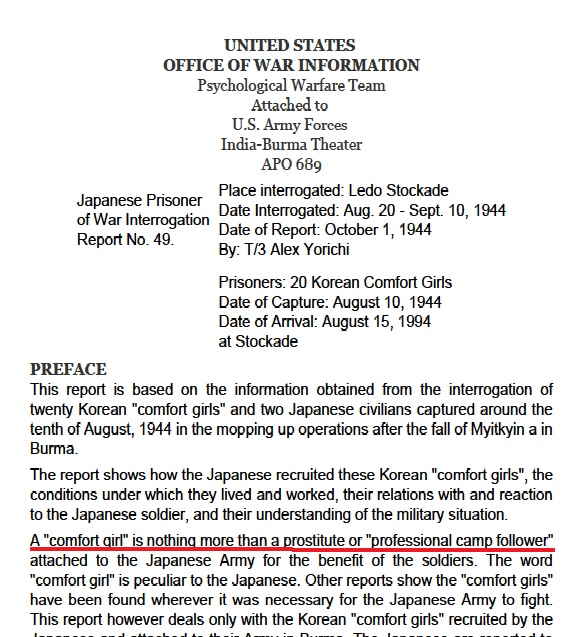

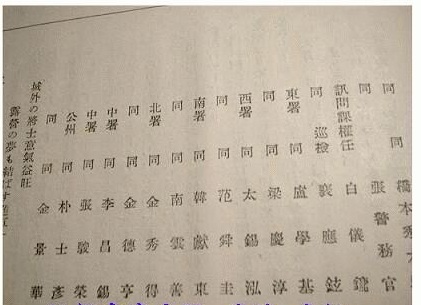

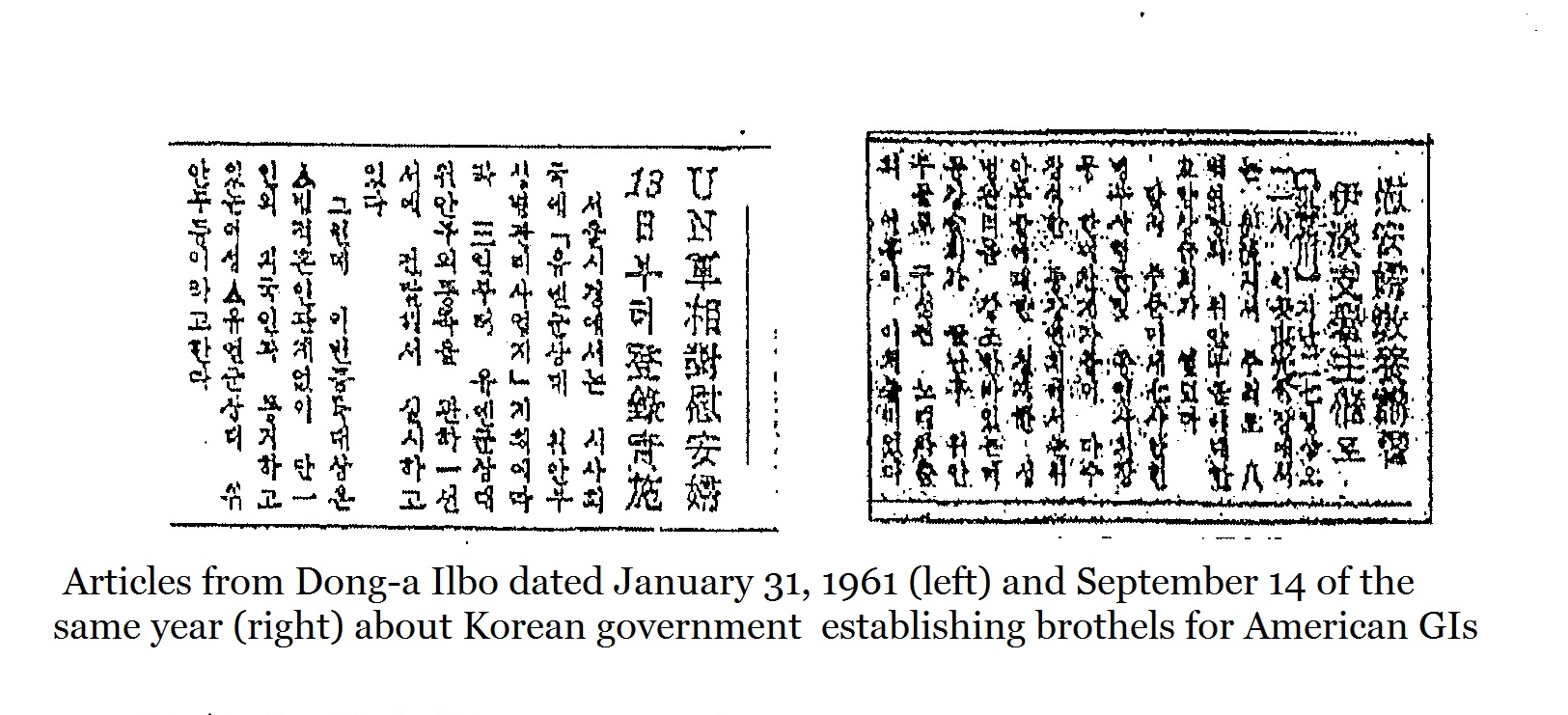
keep up the great work Japan
https://petitions.whitehouse.gov/petition/remove-offensive-state-glendale-ca-public-park/3zLr8dZh
Remove offensive state in Glendale, CA public park
Please remove the statue in a public park in Glendale, California. It is a statue of a Comfort Women masquerading as a peace statue while in essence after reading the inscription it is promoting hate towards the people and nation of Japan.
That is Korean bussiness stile.
“He that is first in his own cause seemeth just; but his neighbour cometh and searcheth him. ” (Bible, Proverbs:18-17)